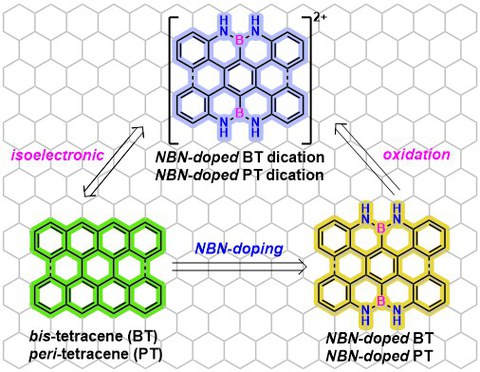Sep 14, 2021
NBN-Doped Bis-Tetracene and Peri-Tetracene: Synthesis and Characterization
The zigzag-edge rich polycyclic aromatic hydrocarbons (PAHs), such as bis-tetracene and peri-tetracene, have attracted increasing attention due to their unique electronic and magnetic properties. However, the instability of bis-tetracene and peri-tetracene caused by the open-shell character limits their further investigations. Thus far, two main strategies, sterically blocking the most reactive position (kinetic stabilization) and heteroatom doping (thermodynamic stabilization), have been established to synthesize stable zigzag-edged higher acenes. Specifically, the introduction of heteroatoms such as boron (B) or nitrogen (N) on the zigzag edges, not only provides access to stable heteroatom-doped acenes but also offers the possibility to tune their electronic structures.
The researchers from the group of Prof. Xinliang Feng in collaboration with the group of Prof. Hong-Jun Gao (Chinese Academy of Sciences) and Dr. Junzhi Liu (The University of Hong Kong) recently demonstrated the synthesis of NBN-doped bis-tetracene (NBN-BT) and peri-tetracene (NBN-PT) through combining solution-based and surface-assisted synthesis methods. Based on the high-resolution STM characterization, NBN-BT adopts a double-helical structure, while NBN-PT displays planar geometry, in which the atomically resolved structure of NBN-PT is further unveiled by nc-AFM characterization. Compared with their carbon-based analogs bis-tetracene (1.56 eV) and peri-tetracene (1.11 eV), the NBN-BT (2.48 eV) and NBN-PT (2.45 eV) exhibit excellent stability under ambient conditions, which is associated with their higher energy gap. Notably, through controlled continuous single-electron chemical or electrochemical oxidation, NBN-BT can be converted into its corresponding radical cation (0.88 eV) and further to dication (1.24 eV), which demonstrates a similar energy gap to its isoelectronic structure bis-tetracene (1.56 eV). This work opens up a new avenue for the synthesis of stable zigzag-edged nanographenes with multi-NBN units and paves the way for investigating the isoelectronic structures of pristine carbon-based zigzag-edged acenes.
Reference: Yubin Fu, Xiao Chang, Huan Yang, Evgenia Dmitrieva, Yixuan Gao, Ji Ma, Li Huang, Junzhi Liu, Hongliang Lu, Zhihai Cheng, Shixuan Du, Hong-Jun Gao, Xinliang Feng. NBN-Doped Bis-Tetracene and Peri-Tetracene: Synthesis and Characterization. Angew. Chem. Int. Ed. 2021, https://onlinelibrary.wiley.com/doi/abs/10.1002/anie.202109808
Acknowledgments: This work was supported by the European Union's Horizon 2020 (No 881603 Graphene Flagship Core3, No 813036 Marie Skłodowska-Curie), ERC Grant on T2DCP, German DFG (Cluster of Excellence “Center for Advancing Electronics Dresden (cfaed) and DFG-NSFC Joint Sino-German Research Project (EnhanceNano, No. 391979941), as well as the DFG-SNSF Joint Switzerland-German Research Project (EnhanTopo, No. 429265950). J. Liu is grateful for the funding support from the Hong Kong Research Grants Council (HKU 27301720) and ITC to the SKL. We thank the National Natural Science Foundation of China (Grant Nos. 61888102, and 61674045), the Ministry of Science and Technology (MOST) of China (No. 2019YFA0308500), as well as the Strategic Priority Research Program of Chinese Academy of Sciences (Grant Nos. XDB30000000). We thank the Center for Information Services and High Performance Computing (ZIH) at TU Dresden for generous allocations of compute resources.

